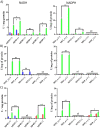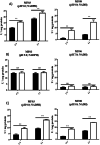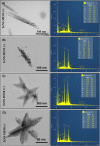In vitro biosynthesis of Ag, Au and Te-containing nanostructures by Exiguobacterium cell-free extracts
- PMID: 32471409
- PMCID: PMC7260758
- DOI: 10.1186/s12896-020-00625-y
In vitro biosynthesis of Ag, Au and Te-containing nanostructures by Exiguobacterium cell-free extracts
Abstract
Background: The bacterial genus Exiguobacterium includes several species that inhabit environments with a wide range of temperature, salinity, and pH. This is why the microorganisms from this genus are known generically as polyextremophiles. Several environmental isolates have been explored and characterized for enzyme production as well as for bioremediation purposes. In this line, toxic metal(loid) reduction by these microorganisms represents an approach to decontaminate soluble metal ions via their transformation into less toxic, insoluble derivatives. Microbial-mediated metal(loid) reduction frequently results in the synthesis of nanoscale structures-nanostructures (NS) -. Thus, microorganisms could be used as an ecofriendly way to get NS.
Results: We analyzed the tolerance of Exiguobacterium acetylicum MF03, E. aurantiacum MF06, and E. profundum MF08 to Silver (I), gold (III), and tellurium (IV) compounds. Specifically, we explored the ability of cell-free extracts from these bacteria to reduce these toxicants and synthesize NS in vitro, both in the presence or absence of oxygen. All isolates exhibited higher tolerance to these toxicants in anaerobiosis. While in the absence of oxygen they showed high tellurite- and silver-reducing activity at pH 9.0, whereas AuCl4- which was reduced at pH 7.0 in both conditions. Given these results, cell-free extracts were used to synthesize NS containing silver, gold or tellurium, characterizing their size, morphology and chemical composition. Silver and tellurium NS exhibited smaller size under anaerobiosis and their morphology was circular (silver NS), starred (tellurium NS) or amorphous (gold NS).
Conclusions: This nanostructure-synthesizing ability makes these isolates interesting candidates to get NS with biotechnological potential.
Keywords: Aerobiosis; Anaerobiosis; Exiguobacterium; Metal(loid); Nanostructure; Reduction.
Conflict of interest statement
The authors declare that they have no competing interests.
Figures





Similar articles
-
Synthesis and Antibacterial Activity of Metal(loid) Nanostructures by Environmental Multi-Metal(loid) Resistant Bacteria and Metal(loid)-Reducing Flavoproteins.Front Microbiol. 2018 May 15;9:959. doi: 10.3389/fmicb.2018.00959. eCollection 2018. Front Microbiol. 2018. PMID: 29869640 Free PMC article.
-
Synthesis and antimicrobial activity of gold/silver-tellurium nanostructures.ACS Appl Mater Interfaces. 2014 Jun 11;6(11):8305-12. doi: 10.1021/am501134h. Epub 2014 May 22. ACS Appl Mater Interfaces. 2014. PMID: 24832728
-
Reduction of Gold (III) and Tellurium (IV) by Enterobacter cloacae MF01 Results in Nanostructure Formation Both in Aerobic and Anaerobic Conditions.Front Microbiol. 2018 Dec 18;9:3118. doi: 10.3389/fmicb.2018.03118. eCollection 2018. Front Microbiol. 2018. PMID: 30619192 Free PMC article.
-
Biosynthesis of silver nanoparticles.J Nanosci Nanotechnol. 2014 Feb;14(2):2038-49. doi: 10.1166/jnn.2014.9019. J Nanosci Nanotechnol. 2014. PMID: 24749472 Review.
-
Synthesis of metallic nanoparticles using plant extracts.Biotechnol Adv. 2013 Mar-Apr;31(2):346-56. doi: 10.1016/j.biotechadv.2013.01.003. Epub 2013 Jan 12. Biotechnol Adv. 2013. PMID: 23318667 Review.
Cited by
-
Biosynthesis of Gold Nanostructures and Their Virucidal Activity Against Influenza A Virus.Int J Mol Sci. 2025 Feb 24;26(5):1934. doi: 10.3390/ijms26051934. Int J Mol Sci. 2025. PMID: 40076560 Free PMC article.
-
Recent Advances in Green Synthesis of Ag NPs for Extenuating Antimicrobial Resistance.Nanomaterials (Basel). 2022 Mar 28;12(7):1115. doi: 10.3390/nano12071115. Nanomaterials (Basel). 2022. PMID: 35407234 Free PMC article. Review.
References
-
- Castro-Severyn J, Pardo-Esté C, Bracho S, Noe Y, Cabezas CE, Gariazzo V, Briones A, Morales N, Séveno M, Decourcelle M, Salvetat N, Remonsellez F, Castro-Nallar E, Molina F, Molina L, Saavedra C. Arsenic response of three altiplanic Exiguobacterium strains with different tolerance levels against the metalloid species: a proteomics study. Front Microbiol. 2019;10:2161. - PMC - PubMed
-
- Castro-Severyn J, Remonsellez F, Valenzuela SL, Salinas C, Fortt J, Aguilar P, Pardo-Esté C, Dorador C, Quatrini R, Molina F, Aguayo D, Castro-Nallar E, Saavedra C. Comparative genomics analysis of a new Exiguobacterium strain from Salar de Huasco reveals a repertoire of stress-related genes and arsenic resistance. Front Microbiol. 2017;8:456. - PMC - PubMed
-
- Kasana RC, Pandey CB. Exiguobacterium: an overview of a versatile genus with potential in industry and agriculture. Crit Rev Biotechnol. 2018;38(1):141–156. - PubMed
-
- Hwang BY, Kim JH, Kim J, Kim BG. Screening of Exiguobacterium acetylicum from soil samples showing enantioselective and alkalotolerant esterase activity. Biotechnol Bioproc E. 2005;10(4):367–371.
-
- Kasana RC, Yadav SK. Isolation of a psychrotrophic Exiguobacterium sp. SKPB5 (MTCC 7803) and characterization of its alkaline protease. Curr. Microbiol. 2007;54(3):224–229. - PubMed
MeSH terms
Substances
Supplementary concepts
Grants and funding
LinkOut - more resources
Full Text Sources
Miscellaneous

